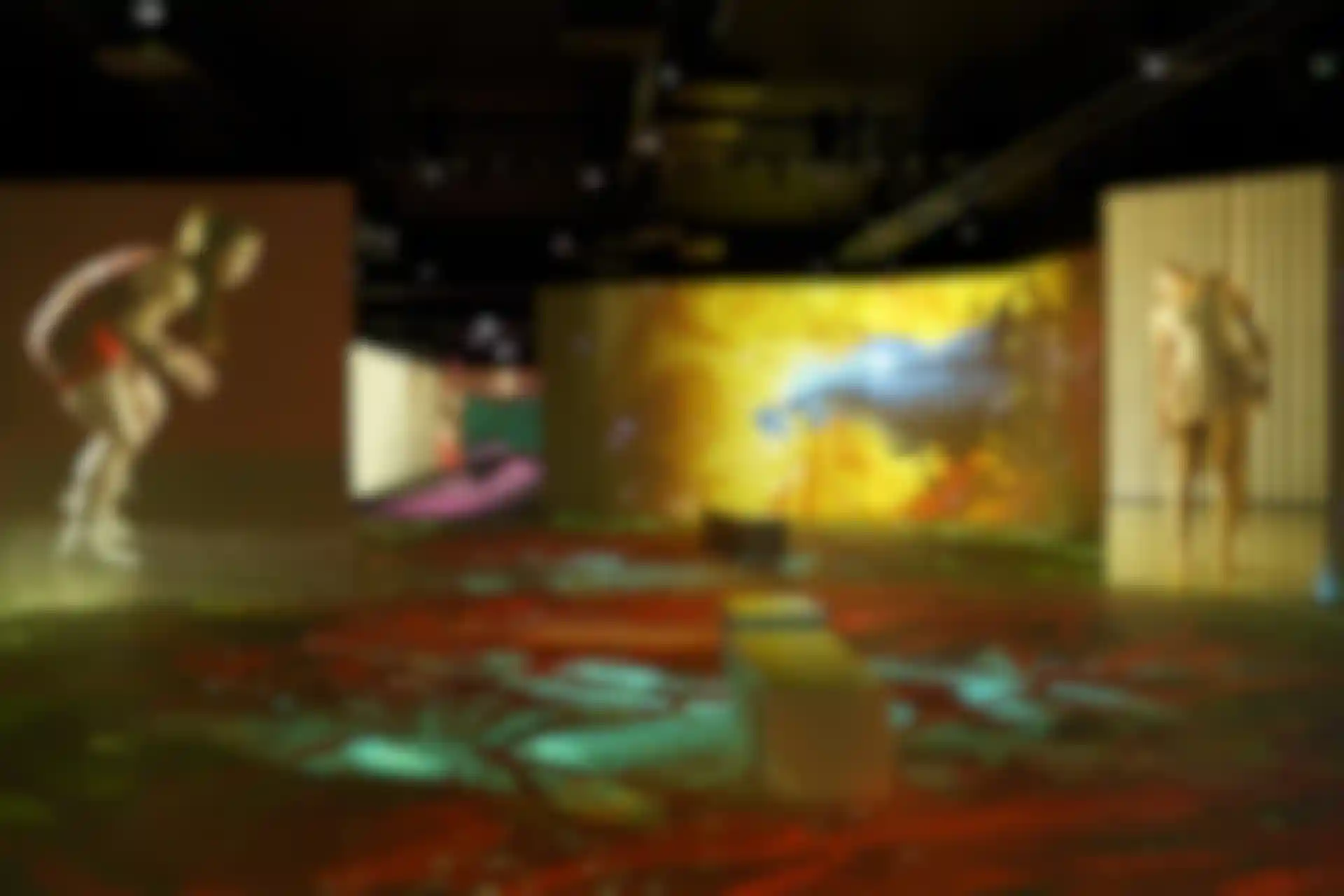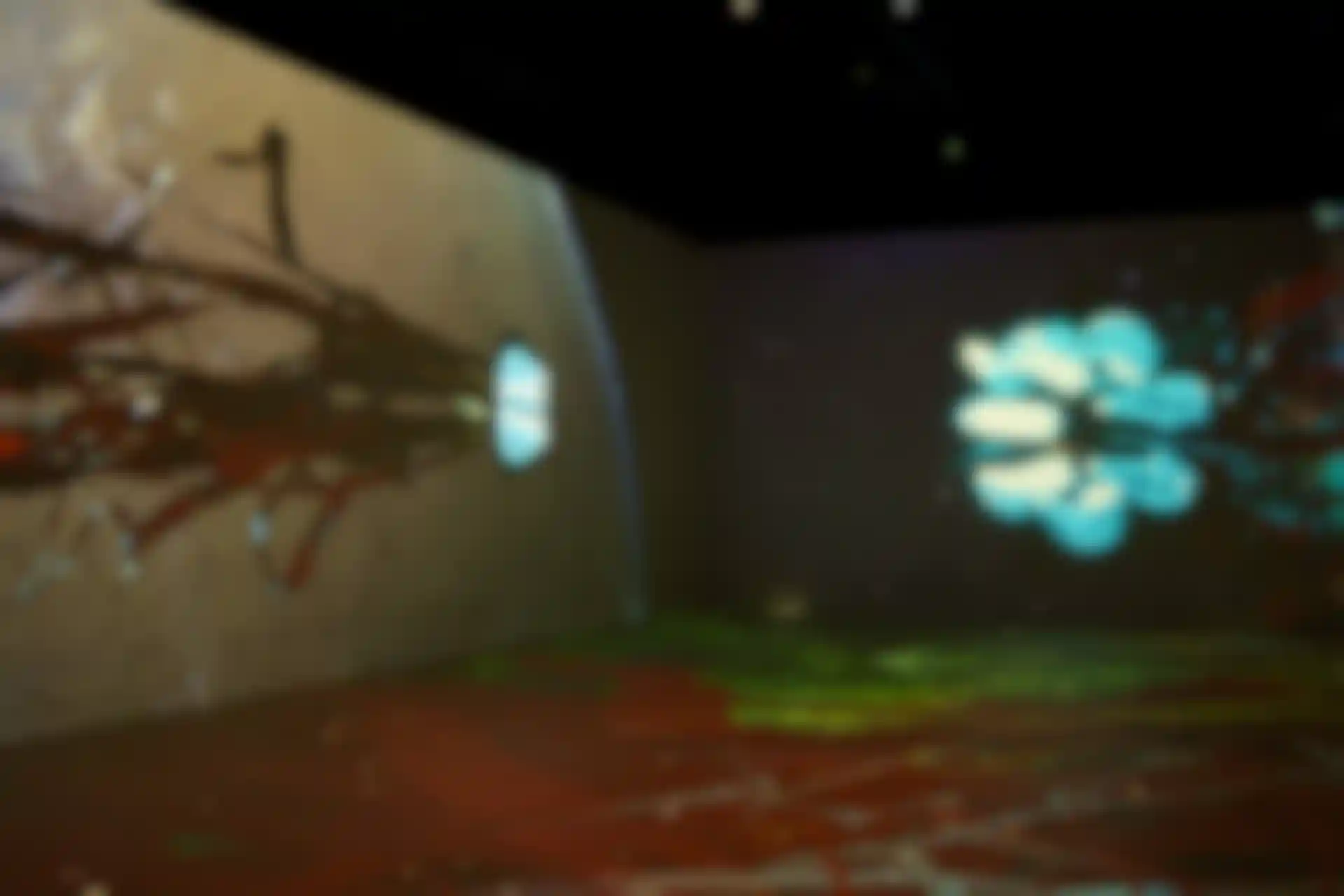
‘Semblant:’ A Dreamscape of Color, Light and Form How artist Charles Borowicz used Maxon One to create an immersive installation at THE LUME.
Multimedia artist Charles Borowicz immerses visitors in a meditative world of vivid color and contrasting visual themes. Projected across walls and floors of THE LUME's 30,000-square-foot digital stage in the Indianapolis Museum of Art at Newfields , his installation, “Semblant,” runs until early 2024.
His work brings together slow-motion closeups of wrestlers and dancers juxtaposed with storm-tossed branches and leaves, alien creatures and starry spacescapes. We talked with Borowicz about how he used Maxon One and After Effects to conceptualize, create and deliver “Semblant” in just three months.
Please tell us about yourself and what inspires you.
Borowicz: I am a video artist and photographer with a Bachelor of Fine Arts in photography from Ball State University in Muncie, Indiana. I enjoy creative collaborations so after college I founded an independent filmmaking collective AnCMovies making shorts and documentaries.

I have also worked on a number of dance-for-screen collaborations. Notably, with Rebecca Pappas on her “Parade” work, Tommy Lewey on their “Red Couch” work and Stephanie Nugent on her “Boat” piece.
I love mathematical concepts, the idea of the sublime and the long look of photography, as in taking time to really look at something. I find inspiration in ideas of Zen, nothingness, absence and the non-events that make up most of existence. I foster a relationship to the world of accepting what you see instead of what you want it to be.
Describe “Semblant” for us and tell us how it came about.
Borowicz: I responded to an invitation from the Indianapolis Museum of Art at Newfields (IMA) for Indiana artists who could fill THE LUME’s huge space with video. I knew I had the skillset and a project concept that would fit that requirement. I was selected alongside Jessica Dunn and Brian Trippi, and we each had the task of creating a unique experience for the space.
My idea for the space evolved from three short videos I’d been working on that explore the themes of power and control, fear and fascination, the mundane and the sublime. Where does one end and the other begin? Encounters with dancers blend with wrestlers, ominous spacescapes give way to the awesomeness of our natural world, and the strange mundanity of driving is set against the still fantastic power of flight.

Designed as an experience to be had rather than a series of images to absorb, I wanted the tangle of relationships between the imagery to be evocative not necessarily prescriptive.
What creative opportunities and challenges did this space offer?
Borowicz: The immense size of THE LUME’s digital projection space is a medium in its own right and gives power to the viewer to choose their encounter. “Semblant” was designed specifically for this space and no walk-through is the same. The relationships between image, viewer and sound are chosen by route more than an edit.
I want people to feel compelled to move through the space drawn by images that catch their attention and pull them through. I think with a space like LUME we should allow the viewer to edit with their gaze.

There were several challenges: the huge amount of content to turn around, the incredible resolution and some projection issues. At three minutes of playback, it came to over 84 billion pixels, which, technically is the most pixels I have ever had to churn out in my life in such a short time. Most of the shots were CG, and I had to manage the color grade in a space where the projectors, about 150 of them, affect each other.
If I didn’t color grade for a specific area, I could have easily made the imagery too bright or lose contrast. I only had one opportunity for a correction pass in the actual space, and, after seeing it, I wished I could have had another one.

How did you manage the short three-month turnaround.
Borowicz: I started in October and working efficiently was critical. Even before I had the full specs from Grande Experiences, who developed the space for the IMA, I began by roughly storyboarding the projection spaces, figuring out what I wanted thematically and movement-wise in the different rooms. Then, I created individual elements, backgrounds, foregrounds and alphas that could be placed across multiple compositions or assembled later.
I made pre-visualizations of the space in Cinema 4D to figure out how the animations functioned in 3D and worked at 15 frames per second instead of 30 to save time. Good depth passes in Cinema 4D also made comping in After Effects easier.
I used Red Giant’s Supercomp to speed up the workflow and manage very complicated timelines with glows and light interaction that would have been so time consuming to handle any other way. It also allowed me to make iterations very quickly instead of searching through layers to fine tune multiple effects every time I changed something.
I was impressed how it handled scenes up to 10K pixels wide just fine. I would not have been able to finish the project without Redshift, the render time savings were insane as well as seeing the previsualizations happen quickly and correctly.
The After Effects template with a 3D walkthrough that Grande Experiences provided was instrumental because we didn’t get access to the space until right at the end. Each wall in THE LUME was its own composition, and there were more than 50 of them spread throughout the space.

Each one had to be lined up and interact correctly, syncing together or frame matching if an element was to move from sequence to sequence. As I started putting the scenes together, I began to understand how they would interact even more clearly, which gave me new ideas, so I had to go back and tweak.
Please walk us through your workflow and how you used different tools.
Borowicz: My main tools for the project were Cinema 4D, Red Giant, After Effects and Redshift. Red Giant’s toolset was central to my creative process, especially Particular and Tao from the Trapcode, VFX plug-ins Supercomp, Optical Glow and Magic Bullet.
Trapcode Particular was a mainstay of my work. I used it to build out a star system as a massive background plate, jacking up the randomizations so that most of the frames felt fairly unique. I rendered out a couple thousand frames, picking sections for a good variety of starfield backgrounds, layering and moving them in Z space to give them a little bit of life, which saved a lot of time.

I also used it to create complex particle flows that subtly enhanced video plates of actual particulates in liquid, using a layer as a particle generator to create a sense of movement.
Trapcode Tao took a more front-and-center role on some sequences, utilizing 3D models built in Cinema 4D but with much quicker rendering and added effects. Being able to choose from several methods to quickly build out an object and control its various qualities makes experimenting with Tao a very flexible option. And using light generators, each with their own movement while themselves being controlled with a null object, was a favorite technique.

When I was ready to composite all the discreet elements together, Supercomp’s tools performed flawlessly with resolutions as high as 10400 pixels by 4080 pixels. From wrapping light to blending edges to consistent black levels, it makes all the sexy and unsexy parts of pulling off a complex After Effects project as easy as it gets.

Finally, I used Optical Glow to create a level of continuity across the whole project. There was a definite difference between using the plug-in in Supercomp or as a stand-alone layer, but it always gave me unique results that were interesting to play with. I also tied some of the Optical Glow effects to sound triggers, creating a subtle relationship between how sound affected changes in Glow.
Magic Bullet Looks was another great and intuitive tool for quick color correction that complements Lumetri Color in After Effects, making it quicker to render once layers were beginning to stack up.
What are you working on now that you can tell us about?
Borowicz: I’m currently focusing on a solo project, “Car Portraits,” a street photography series of portraits of people as they drive on the interstate, and I hope to have the book sometime next year. I am also working on a few music videos, and I’m in pre-production of a full-length, sci-fi-type movie about art, nothingness, mathematics and the end of all things, so nothing too heavy.